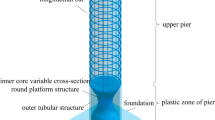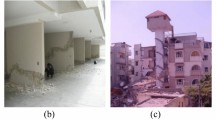Abstract
This study attempts to evaluate the effect of transverse shear keys in mitigating the transverse irregularity of continuous girder bridge with unequal height piers through differential strength design. In the current specifications, widely adopted reinforced concrete shear keys are mostly considered as structural measures, while their role in the transverse seismic system of girder bridges is not defined in detail. To explore the potential of reasonable design of shear keys on mitigating the transverse irregularity of multi-span continuous girder bridge with unequal pier heights under different seismic systems, a systematic study is performed based on OpenSees platform. Parametric analysis of the shear key strength is carried out to meet the expected performance objectives of the bridge under different transverse seismic systems. This study leads to the conclusion that rational differential design of transverse shear key strength on different height piers of mid-span continuous girder bridges balance the total transverse stiffness of piers, thus there would be a reasonable distribution of seismic inertia force transmitted from superstructure. This makes the transverse seismic responses of different height piers consistent and seismic performance requirements would be meet under different transverse seismic system. For mid-span continuous girder bridges with different height piers, ductile seismic system can be adopted when the strength of the shear keys is high, and the difference between strength of the shear keys at different height piers should be small. The seismic reduction and isolation system can be adopted in continuous girder bridge with weaker shear keys, while the strength of the shear keys at high pier should be relatively more smaller than that of shear keys at short pier.





















Similar content being viewed by others
References
Guirguis, J.E.B.; Mehanny, S.S.F.: Evaluating code criteria for regular seismic behavior of continuous concrete box girder bridges with unequal height piers. J. Bridg. Eng. 18(6), 486–498 (2013)
Rezaei, H.; Moayyedi, S.A.; Jankowski, R.: Probabilistic seismic assessment of RC box-girder highway bridges with unequal-height piers subjected to earthquake-induced pounding. Bull. Earthq. Eng. 18(4), 1547–1578 (2019)
Xiang, N.; Li, J.: Utilizing yielding steel dampers to mitigate transverse seismic irregularity of a multispan continuous bridge with unequal height piers. Eng. Struct. 205, 110056 (2020)
Ishac, M.; Mehanny, S.: Do mixed pier-to-deck connections alleviate irregularity of seismic response of bridges with unequal height piers. Bull. Earthq. Eng. 15(1), 97–121 (2016)
Lv, Y.: Effects of SSI on seismic responses of unequal height pier bridge. J. Vibroeng. 19(5), 3599–3609 (2017)
Wu, W.; Wu, Z.; Li, L.; Long, S.: Fragility analysis of isolation effect for plate-type elastomeric bearing on continuous girder bridges with unequal height piers. In: 2018 3rd International Conference on Smart City and Systems Engineering (ICSCSE), 2018, pp. 32–37.
Company, H.E.: Seismic and Retrofit of Bridges—From Post-Disaster Emergency Repair to Seismic Maintenance and Reinforcement. China Architecture & Building Press, Beijing (2013).
Ministry of Construction of the PRC. Code for Seismic Design of Railway Engineering (2009 edition). China Planning Press, Beijing. GB50111-2006 (in Chinese)
MTC (Ministry of Transport of China). Specifications for Seismic Design of Highway Bridge. Beijing: MTC. JTG 2231-01-2020 (in Chinese)
Bozorgzadeh, A.M.; Sami, R.; José, I.A.; Scott, A.: Capacity evaluation of exterior sacrificial shear keys of bridge abutments. J. Bridge Eng. 11(5), 555–565 (2006)
Du, X.; Zhong, Z.; Han, Q.; Zhou, Y.: Seismic capacity evaluation of exterior shear keys of highway bridges. J. Bridge Eng. (2017). https://doi.org/10.1061/(ASCE)BE.1943-5592.0000978
Han, Q.; Zhou, Y.; Ou, Y.; Du, X.: Seismic behavior of reinforced concrete sacrificial exterior shear keys of highway bridges. Eng. Struct. 139, 59–70 (2017)
Li, J.; Tang, H.; Guan, Z.: Shake table test and numerical analysis of a bridge model supported on elastomeric pad bearings. J. Earthq. Eng. 21(4), 604–634 (2016)
Xu, L.; Li, J.: Seismic Strength Prediction of Reinforced Concrete Retainers Based on Rigid Body Rotation Model. Eng. Mech. 31(2014), 143–150 (2014) (in Chinese)
Wu, G.; Wang, K.; Zhang, P.; Lu, G.: Effect of mechanical degradation of laminated elastomeric bearings and shear keys upon seismic behaviors of small-to-medium-span highway bridges in transverse direction. Earthq. Eng. Eng. Vib. 17(1), 205–220 (2018). https://doi.org/10.1007/s11803-018-0435-z
Xiang, N.; Li, J.: Seismic performance of highway bridges with different transverse unseating-prevention devices. J. Bridge Eng. (2016). https://doi.org/10.1061/(ASCE)BE.1943-5592.0000909
Xiang, N.; Alam, M.S.; Li, J.: Shake table studies of a highway bridge model by allowing the sliding of laminated-rubber bearings with and without restraining devices. Eng. Struct. 171, 583–601 (2018)
Xiang, N.; Alam, M.S.; Li, J.: Yielding steel dampers as restraining devices to control seismic sliding of laminated rubber bearings for highway bridges: analytical and experimental study. J. Bridge Eng. (2019). https://doi.org/10.1061/(ASCE)BE.1943-5592.0001487
Xu, L.; Fu, P.; Billie, F.S.: Maintaining bridge alignment during seismic events: shear key design and implementation guidelines. J. Bridge Eng. 25(5), 04020017 (2020)
Ehsan, A.; Mohammad, M.K.: Numerical investigation of nonlinear static and dynamic behaviour of self-centring rocking segmental bridge piers. Soil Dyn. Earthq. Eng. 128, 105876 (2020)
M.J.N. Priestley, Seismic Design and Retrofit of Bridges, 1996.
Aygün, B.; Dueñas-Osorio, L.; Padgett, J.E.; Des Roches, R., et al.: Efficient longitudinal seismic fragility assessment of a multispan continuous steel bridge on liquefiable Soils. J Bridge Eng 16(1), 93–107 (2011)
Nielson, B.G.; Des Roches, R.: Seismic fragility methodology for highway bridges using a component level approach. Earthq Eng Struct Dyn 36(6), 823–839 (2007)
Nielson, B.G.; Des Roches, R.: Analytical Seismic fragility curves for typical bridges in the central and Southeastern United States. Earthq Spectra 23(3), 615–633 (2007)
Ledezma, C.: Performance-Based Earthquake Engineering Design Evaluation Procedure for Bridge Foundations Undergoing Liquefactioninduced Lateral Spreading. Ph.D. dissertation, Univ. of California, Berkeley, Berkeley, Calif. (2007)
Taner, Y.; Banerjee, S.; Peggy, A.J.: Performance of two real-life California bridges under regional natural hazards. J. Bridge Eng. 21(3), 1–15 (2016)
Xiang, N.; Li, J.: Research on proper design parameters of concrete shear keys for short and medium span beam bridge. Bridge Constr 46, 41–46 (2016) ((in Chinese))
Acknowledgements
This work is supported by the National Nature Science Foundation of China (Grants No. 51678459). The authors are very grateful for the supports. Any opinions, findings, and conclusions expressed herein are those of the authors and do not necessarily reflect the views of the sponsors.
Author information
Authors and Affiliations
Corresponding author
Rights and permissions
Springer Nature or its licensor (e.g. a society or other partner) holds exclusive rights to this article under a publishing agreement with the author(s) or other rightsholder(s); author self-archiving of the accepted manuscript version of this article is solely governed by the terms of such publishing agreement and applicable law.
About this article
Cite this article
Deng, Y., Ge, S. & Ge, X. Mitigating Seismic Irregularity of Continuous Girder Bridge with Unequal Height Piers Through Differential Design of Shear Key Strength. Arab J Sci Eng 48, 13749–13769 (2023). https://doi.org/10.1007/s13369-023-07965-9
Received:
Accepted:
Published:
Issue Date:
DOI: https://doi.org/10.1007/s13369-023-07965-9




